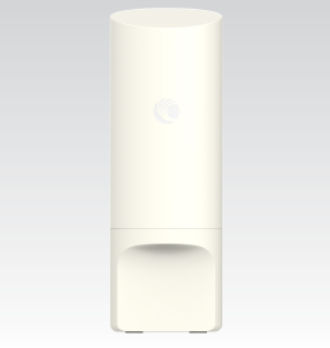
Cambium Networks Wi Fi 6/ Wi Fi-6E
Designed to deliver high-density, future-proof performance for building next generation wireless networks

New 6GHz spectrum brings the dream of digital learning closer to reality, today
We all dream of the days when our children learn through exciting, immersive experiences, curated and guided by their teachers, regardless of socio-economic status. This reality is closer than you might think thanks to the new 6 GHz spectrum made accessible by Wi-Fi 6E based networks.

So how does Wi-Fi 6E fit into this? First of all, let’s start with what Wi-Fi 6E is. The most important aspect of this new flavor of Wi-Fi is that it adds support for the 6 GHz band. This expands the available spectrum for Wi-Fi by two to three times (results differ by country). This represents by far the largest expansion of capacity for Wi-Fi in its 25-year history and means there is a lot more space available for Wi-Fi to support reliable, congestion-free connections. There are other enhancements in Wi-Fi 6 and 6E, including improvements in high-density Wi-Fi client support and reduced traffic latency. These types of improvements are very relevant for education where high densities of students and devices require connectivity in classrooms, auditoriums, libraries, sports venues and more for critical applications.
The trends around technology dependency and usage requirements are ever on an upward trend in education as new applications are incorporated into curriculum. Some examples include:
- Online testingand assessments
- Video collaboration applications such as Zoom, Meet and Teams supporting remote and hybrid learning. W
- High-bandwidth applicationssuch as augmented reality/virtual reality (AR/VR), which will see increased usage over time and bring even more stringent requirements to wireless networks.
For purchase decisions being made today or in the near future, should Wi-Fi 6E be considered given the benefits it brings? A few points to consider:
- Network lifespan – The average life of a Wi-Fi network is about five years. There is no doubt that Wi-Fi 6E will become significantly more pervasive in usage during this timeframe.
- Client availability – While there are not many Wi-Fi 6E clients in use today, they have been available since the beginning of 2021. The number of total shipments globally is in the hundreds of millions. There are very likely Wi-Fi-6E-capable clients on your network today. A number of mobile phones and some laptops support Wi-Fi 6E as of the beginning of 2022 with more coming to market over time.
- Economics – When new technology becomes available, it may come at a premium price. Price is typically a very important consideration in education, so investment in Wi-Fi 6E must be viewed in light of what benefits it will deliver relative to other solutions on the market.
Given this background, how are Cambium Networks’ Wi-Fi 6E solutions applicable to the needs of the educational market–today and tomorrow?
The introduction of Wi-Fi 6E represents a watershed moment for Wi-Fi. The technological advances it provides together with true economic advantages make a compelling combination for educational institutions to consider when investing in their networks for the future.
- Better Wi-Fi 6 now – Despite the fact that you may not have many or any Wi-Fi 6E clients on your Wi-Fi network today, Cambium’s Wi-Fi 6E represent a better Wi-Fi access point to support your existing network and clients. With more radios compared to standard APs–three or five radios on Cambium’s XE3-4 and XE5-8 AP models respectively vs. two radios on a typical Wi-Fi 6 AP–you have greater capacity and flexibility supporting existing Wi-Fi 5 and Wi-Fi 6 clients on your network today. The new APs also leverage the latest, greatest processor and radio chipsets. You are buying ahead in the technology cycle and will be able to take advantage of better performance and features/functionality with the new solutions even without enabling the 6 GHz band
- Migrate when ready – The XE-series APs support software-defined radios, meaning that select radios on the APs can be configured to run either in Wi-Fi 6 5 GHz or Wi-Fi 6E 6 GHz mode. You can configure these APs as Wi-Fi 6 devices today and reprogram radios to operate in 6 GHz when those devices start to show up on the network in larger numbers. Cambium’s cnMaestro™ and XMS-Cloud will automatically monitor the Wi-Fi network and recommend when you should enable 6 GHz. This type of flexibility is key when new technology is introduced – compatibility with existing requirements while providing a roadmap to the future when you are ready. The benefits of this include investment protection and system longevity.
- Optimized high density – The Cambium XE5-8 AP is completely unique in the industry with five Wi-Fi radios capable of supporting hundreds of devices with a single AP (absolute maximum is 2,500). For locations where high-density Wi-Fi usage is seen, e.g., auditoriums, gymnasiums, student centers, sports arenas, libraries, cafeterias, etc., the XE5-8 is ideal as one AP can replace three to four traditional two-radio APs. This reduces equipment costs, cable runs, installation costs, power consumption and maintenance costs, collectively reducing the total cost of ownership by a significant amount.
- Future proof without a premium – A key criterion for many schools considering a new Wi-Fi infrastructure investment is cost. Cambium’s Wi-Fi 6E solutions effectively bring this new technology to the market without a cost premium compared to previous Wi-Fi generations. With the benefits of more radios per AP and software-defined radios, the new XE-series APs can replace multiple traditional APs depending on the deployment scenario. This can provide significant cost savings and actually lowers total system costs compared to previous-generation solutions.
When to Upgrade the Network to Wi-Fi 6 ?
When deciding when to consider a network upgrade, network operators need to calculate the cost/benefit of upgrading to 802.11ax. The new Wi-Fi 6 access points improve performance and efficiency beyond 802.11ac networks even without the use of 802.11ax devices. By upgrading now, businesses can deliver more simultaneous video streams, and support more concurrent users and devices than before.
Factors recently ratified include the availability of equipment and support and the population of Wi-Fi 6 devices. Other factors include:
- Client and ecosystem support including standards ratification and interoperability support
- Density growth trends
- Backward compatibility with legacy devices and systems
- Available RF spectrum within a crowded RF neighborhood
- State of IoT applications if applicable
- Equipment cost
Increased Streaming Content & New Devices Drive the Need for Wi-Fi 6
Streaming video over the Internet accounts for 82% of all Internet traffic. The 2020s will bring widespread use of IOT devices in every home and enterprise and more personal devices. Additionally, 8k video will become commonplace and streaming media bitrates will rise again. Wi-Fi 6 will meet the capacity needs going forward.

MU-MIMO Technology
As the 802.11ax technology evolves, MU-MIMO will work in both downstream and upstream directions. Another key advantage with 802.11ax is support for eight concurrent MU-MIMO transmissions concurrently, double the number supported by 802.11ac. One of the limiting factors for MU-MIMO in 802.11ac is the high management overhead required to communicate subcarrier information to the access point. In 802.11ax, enhancements to MU-MIMO will include grouping multiple client updates together to improve protocol efficiency and remove excess management overhead. The capacity and high throughput advantages make MU-MIMO another key technology for 802.11ax.
The 802.11 Standard – the foundation of Wi-Fi 6
The 802.11ac standard introduced in 2013 builds on several successful technologies from 802.11n. 802.11ac allows wider channel bonding up to a practical limit of 80 MHz, airtime fairness and standardized beam-forming. Also, 802.11ac wave 2 technology introduced multi-user MIMO (DL MU-MIMO) capability to help bridge the gap between the access point capability and the client device capability. Access points are physically larger, support more antennas, are plugged into the AC mains for continuous power, and include high-performance CPUs and DRAM. Client devices are designed for great cameras and screens but do not have the CPU processing power to use multiple streams and do not have space for optimal antenna design. Thus, MU-MIMO allows the access point to transmit concurrently to more than one client at a time. In 802.11ac, MU-MIMO is limited to downstream packet only, thus it is often written as DL MU-MIMO.
Whereas 802.11ac made the network faster, 802.11ax is designed for higher channel efficiency in a dense networking environment. The key technology behind 802.11ax, multiple access OFDMA, comes from the 3GPP LTE cellular technology and 802.16e WiMax. OFDMA, orthogonal frequency division multiple access, is a field-proven technology to support higher density wireless networks. 802.11ax anticipates higher density in several ways; scheduled transmission time, dynamic frequency allocation in 2 MHz increments, spatial reuse and improved battery management mechanisms.

OFDMA Technology
OFDMA divides up the 20 MHz channel into 256 subcarriers. The smallest unit is 26 subcarriers in 2 Mhz of frequency. These subcarriers can be grouped together into larger units; at 52 (4 Mhz), 106 (8 Mhz), and 242 (20 Mhz) to support higher bandwidth applications. Each grouping of subcarriers are called a resource unit (RU).
Any single client device is assigned one or more RU. Each RU can be transmitted at a unique QAM level. Additionally, as the client device moves farther away from the access point, the number of RU and the QAM level can be adjusted to maintain a strong signal level even as throughput degrades.




